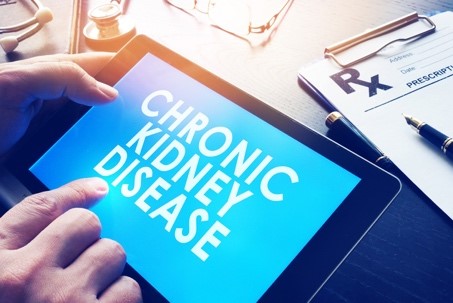
Boston—Treatment-resistant hypertension is a common complication of chronic kidney disease (CKD), yet the use of renin-angiotensin-aldostyerone system inhibitor (RAASi) drugs may be limited in patients with CKD due to hyperkalemia. The PATHWAY-2 trial demonstrated that spironolactone was an effective fourth-line therapy for treatment-resistant hypertension; however, patients with advanced CKD were excluded from that trial.
The phase 2 AMBER study was designed to assess the use of the potassium binder patiromer concomitantly with spironolactone in patients with treatment-resistant hypertension and advanced CKD to prevent hyperkalemia and allow more persistent spironolactone use for blood pressure control. Rajiv Agarwal, MD, MBBS, FASN, reported results during a late-breaking poster session at the NKF Spring Clinical Meetings in a poster titled Patiromer to Enable Spironolactone in Patients with Resistant Hypertension and CKD: Primary Results of AMBER.
The multicenter, double-blind, placebo-controlled randomized controlled trial included a 4-week screening/run-in period and a 12-week treatment period. Eligible patients were adults with CKD and uncontrolled resistant hypertension (defined as unattended screening systolic automated office blood pressure 135-1260 mm Hg while on three anti-hypertensive drugs, including a diuretic, and an angiotensin-converting enzyme inhibitor or angiotensin II rceptor blocker). Other inclusion criteria were estimated glomerular filtration rate 25 to ≤45 mL/min/1.72 m2 and screening potassium level 4.3 to 5.1 mEq/L.
The primary efficacy end point is the between-group difference (spironolactone + patiromer vs spironolactone + placebo) in the percentage of patients remaining on spironolactone at week 12. Secondary end points included the between-group difference in systolic automated office blood pressure change from baseline to week 12.
A total of 295 patients were randomized, creating a sample size that provides 90% power sufficient to detect a difference of ≥20% between treatment groups in the proportion of patients remaining on spironolactone at week 12 at a=0.05. The database lock was January 31,. 2019.
“AMBER is the first randomized, controlled study of spironolactone in the treatment of resistant hypertension in patients with advanced CKD and will define the safety and effectiveness of spironolactone and if patiromer can facilitate the use of spironolactone to lower blood pressure in patients with resistant hypertension and CKD,” the researchers said.
In late-breaking results, the researchers reported that the study “achieved statistical significance of its prespecified primary end point by demonstrating that a significantly higher proportion of patients taking Veltassa® [patiromer] remained on therapy through 12 weeks of treatment versus placebo with concomitant spironolactone in patients with resistant hypertension and CKD (86% vs 66%, P<.001, respectively). Safety results are consistent with existing Veltassa data, with no new safety issues identified.1”
Source: Agarwal R, Rossignol P, Garza D, et al. Patiromer to enable spironolactone in patients with resistant hypertension and CKD: primary results of AMBER. Abstract of a poster presented at the National Kidney Foundation 2019 Spring Clinical Meetings, May 8-12, 2019, Boston, Massachusetts.
1. Vifor Pharma’s phase 11 AMBER study meets primary end point [press release]. May 13, 2019.







 © 2025 Mashup Media, LLC, a Formedics Property. All Rights Reserved.
© 2025 Mashup Media, LLC, a Formedics Property. All Rights Reserved.